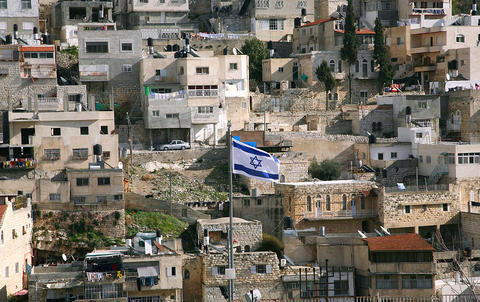Amin al-Siyam says he is awakened nearly every night by the sound of Jewish settlers tunneling under his east Jerusalem house toward the Old City's deeply sensitive Al-Aqsa mosque compound.
"We hear them at night, under the house. Sometimes the whole building shakes. Then they leave the next morning, early," Siyam says.
Siyam lives in the heart of one of the world's most bitterly contested cities, his house sitting above a tunnel that has struck a new fault line in the Middle East conflict.

PHOTO: AFP
The house faces an archeological dig in the Arab neighborhood of Silwan in annexed east Jerusalem, just a few hundred meters from Judaism's holiest site and Islam's third holiest site -- which occupy the same space.
Jews call it Temple Mount, the site of the Second Temple destroyed by the Romans in 70AD.
Muslims call it Haram al-Sharif, or Noble Sanctuary, from which they believe their prophet Mohammed ascended to heaven on a horse.
Angry protests and even fierce clashes have erupted whenever one group believes the other is encroaching on its sacred turf.
The most recent Palestinian uprising broke out in 2000 after right-wing Israeli prime minister Ariel Sharon visited Al-Aqsa and an Israeli project to repair a nearby ramp sparked widespread protests in February last year.
The Silwan project has aroused similar suspicions, in part because people are not allowed to see the tunnel, but primarily because the work is being funded by the Ir David Foundation, an Israeli settler group.
The site, on a narrow, traffic-choked street running down the steep southern slope outside the Old City's walls is surrounded by a high metal fence, with a large Israeli flag fluttering over a padlocked gate.
The Israeli Antiquities Authority (IAA) says it has found an ancient tunnel that once carried rainwater from the heart of the Old City to a ritual bathhouse several hundred meters away.
"It was a brand new tunnel from 2,000 years ago," IAA head Shuka Dorfman said. "The condition of the tunnel was unbelievable."
Starting in 2004 archeologists excavated most of the tunnel between the dig site and the bathhouse.
But last month they started working north in the direction of Temple Mount/Haram al-Sharif.
Based on a late 19th century British excavation of large sections of the tunnel, archeologists believe the tunnel leads to the Old City, veering close to the mosque complex but not passing beneath it.
Yet because the project is being carried out in secret and funded by a settler organization, many residents think it is part of a plan to take over -- or destroy -- Haram al-Sharif.
"If it is an archeological site and not a settlement, if it is a tourist site, then why can't we go and see it? Why can't anyone see it?" asked Ahmed Qarain, 37, a local resident.
The IAA has refused to allow anyone from the neighborhood or the media to see the northern section of the tunnel and declined several requests from AFP to comment on how much of it has been excavated.
Officials there gave no reason for the ban, other than to say the work was in progress. However, they promised media would be invited once the project is completed.
Residents have set up a protest tent nearby and filed a lawsuit arguing they were not consulted on a dig they say runs beneath their homes. On March 17 an Israeli court ordered a halt to the project while it considers the case.
Dorfman says the objections are purely political and have nothing to do with the antiquities authority.
"We are a nonpolitical organization. We are a professional organization and an organization that is working according to the law of antiquities," he says. "I don't care about politics."
Residents' distrust of Israeli archeology is rooted in their history with the Ir David Foundation, which funds several digs in the area, including the Silwan tunnel project.
The foundation has created the City of David, an archeological park built around what it believes to be ruins from the time of the legendary Hebrew king, who ruled in Jerusalem some 3,000 years ago.
Ir David provides as much as US$600,000 a year to the IAA for projects in and around the City of David, but says it plays no part in the actual digging.
However, the foundation has sought to create a "living testament" to the historic Jewish presence in the mostly Palestinian neighborhood.
"This is the most important place in the world for the Jewish people. We have been waiting for 2,000 years to come back to this area," said Doron Spielman, a senior foundation executive.
A white limestone street of newly built homes secured by heavy doors and cameras and decked with Israeli flags juts into Silwan, an extension of the park built to look like the Jewish quarter of the Old City.
"Building a residential Jewish community is definitely a priority of the organization," Spielman said, but he insisted the foundation enjoys good relations with Arab residents.
Meir Margalit, a spokesman for the Israeli Committee Against Housing Demolitions, said: "The problem is not the archeological digging, it is the agenda of the people who are behind the digging."
He and other Israeli activists fear that sensitive projects like Silwan, if left in the hands of right-wing groups, could one day be used to detonate the Middle East peace process.
"For a long time this has been a problematic issue, but now it is a dangerous issue," Margalit said.
Yoni Mizrachi, an Israeli archeologist critical of Ir David, said IAA reliance on it for funding ties them to its agenda.
"They need the money, and they are not just doing this for the benefit of archeology," Mizrachi said. "It's one of the few sites operated by private organizations and it is the only one run by a right-wing organization."
Israel occupied and annexed east Jerusalem in 1967, a move not recognized by any other country or by the Palestinians, who have demanded the mostly Arab half of the city as their future capital.
But Silwan's residents say the foundation is slowly tunneling its way toward control of the entire neighborhood.
"You start wondering what is happening when they change the names of places," Qarain says. "This is Silwan, but they call it Ir David. We know this street as Wadi Helwa Siyam, but they put up signs calling it Maale David."
In the climate of fear and distrust that prevails in Jerusalem the kind of nonpolitical archeology that the IAA claims to practice may be impossible, but the secrecy around the project is not dispelling the controversy.
"Nobody knows how long these tunnels are and how far they have excavated so far," Mizrachi says. "Nobody knows anything."

Shamans in Peru on Monday gathered for an annual New Year’s ritual where they made predictions for the year to come, including illness for US President Donald Trump and the downfall of Venezuelan President Nicolas Maduro. “The United States should prepare itself because Donald Trump will fall seriously ill,” Juan de Dios Garcia proclaimed as he gathered with other shamans on a beach in southern Lima, dressed in traditional Andean ponchos and headdresses, and sprinkling flowers on the sand. The shamans carried large posters of world leaders, over which they crossed swords and burned incense, some of which they stomped on. In this

The death of a former head of China’s one-child policy has been met not by tributes, but by castigation of the abandoned policy on social media this week. State media praised Peng Peiyun (彭珮雲), former head of China’s National Family Planning Commission from 1988 to 1998, as “an outstanding leader” in her work related to women and children. The reaction on Chinese social media to Peng’s death in Beijing on Sunday, just shy of her 96th birthday, was less positive. “Those children who were lost, naked, are waiting for you over there” in the afterlife, one person posted on China’s Sina Weibo platform. China’s

‘NO COUNTRY BUMPKIN’: The judge rejected arguments that former prime minister Najib Razak was an unwitting victim, saying Najib took steps to protect his position Imprisoned former Malaysian prime minister Najib Razak was yesterday convicted, following a corruption trial tied to multibillion-dollar looting of the 1Malaysia Development Berhad (1MDB) state investment fund. The nation’s high court found Najib, 72, guilty on four counts of abuse of power and 21 charges of money laundering related to more than US$700 million channeled into his personal bank accounts from the 1MDB fund. Najib denied any wrongdoing, and maintained the funds were a political donation from Saudi Arabia and that he had been misled by rogue financiers led by businessman Low Taek Jho. Low, thought to be the scandal’s mastermind, remains

Australian Prime Minister Anthony Albanese yesterday announced plans for a national bravery award to recognize civilians and first responders who confronted “the worst of evil” during an anti-Semitic terror attack that left 15 dead and has cast a heavy shadow over the nation’s holiday season. Albanese said he plans to establish a special honors system for those who placed themselves in harm’s way to help during the attack on a beachside Hanukkah celebration, like Ahmed al-Ahmed, a Syrian-Australian Muslim who disarmed one of the assailants before being wounded himself. Sajid Akram, who was killed by police during the Dec. 14 attack, and